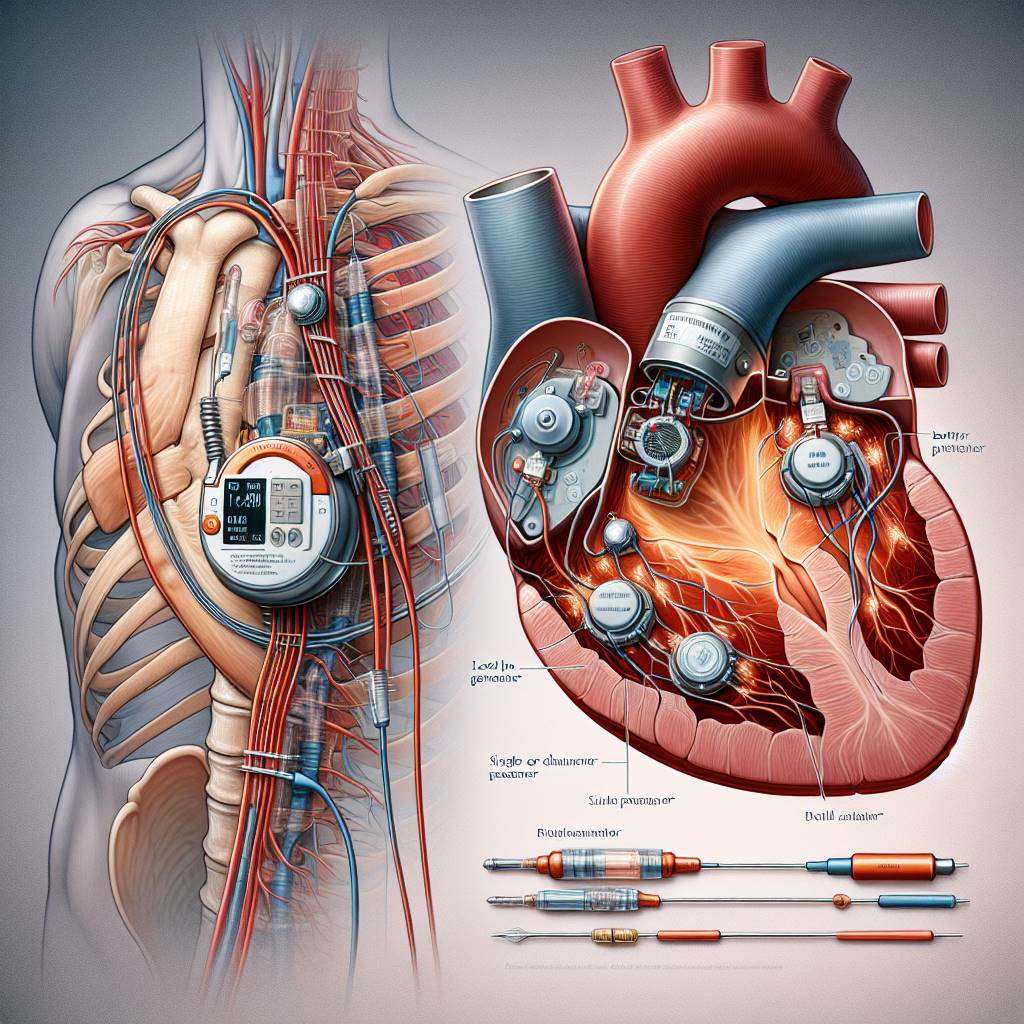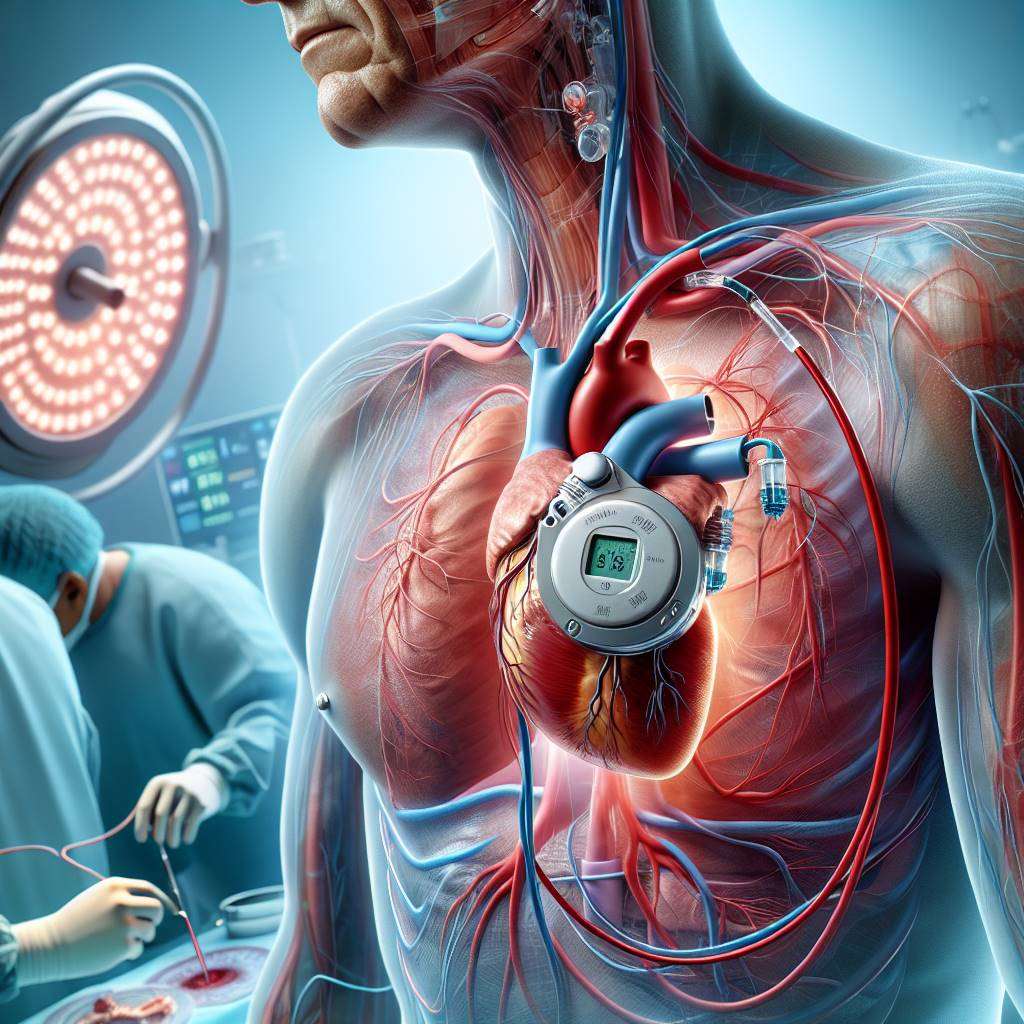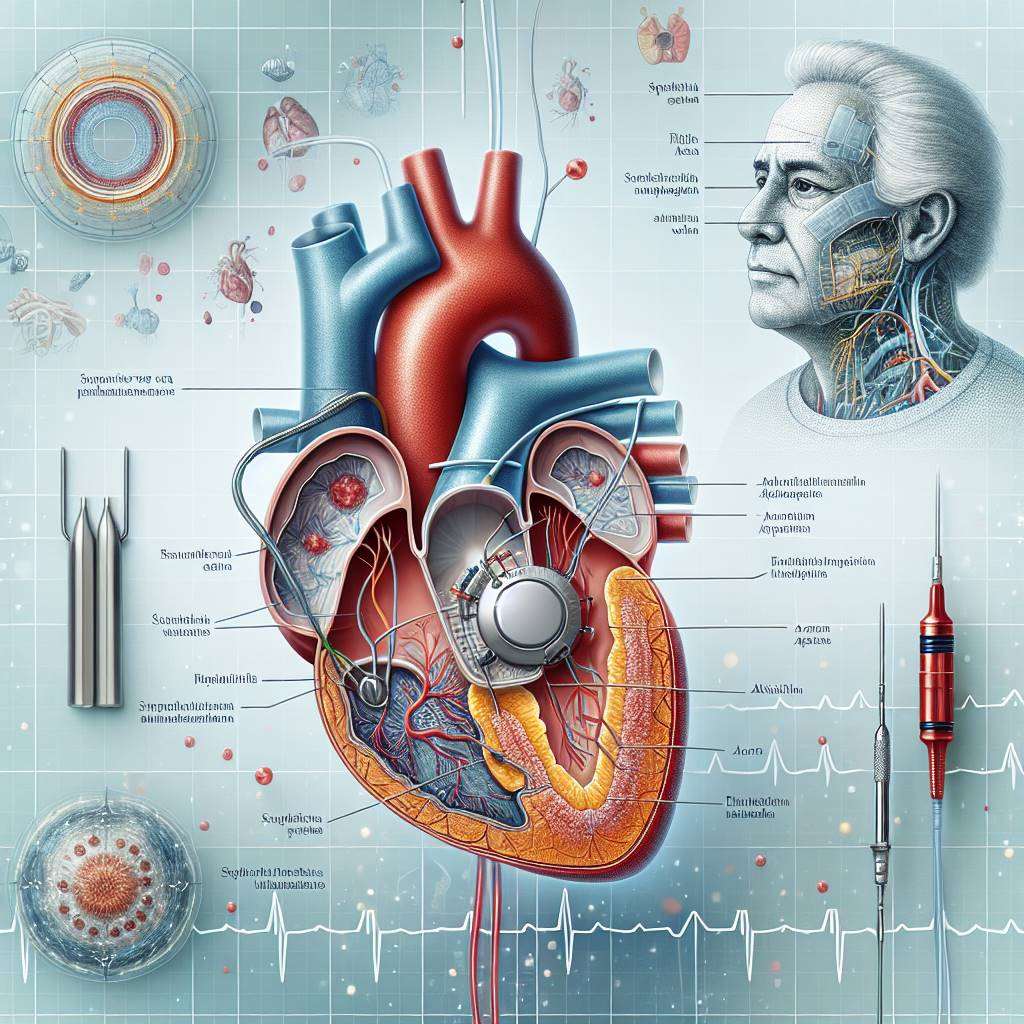Pacemakers are life-saving devices used to manage abnormal heart rhythms, also known as arrhythmias. Among the most common types are single-chamber and dual-chamber pacemakers, each designed to address specific cardiac needs. Understanding their differences is crucial for patients and healthcare providers to make informed decisions about treatment.
Choosing between a single-chamber and dual-chamber pacemaker depends on the patient's condition, such as bradycardia or heart block. These devices play a vital role in improving quality of life and preventing complications. This article explores their functions, differences, and benefits to help patients and caregivers better understand their options.
What Are Single-Chamber and Dual-Chamber Pacemakers?
A single-chamber pacemaker is a device that stimulates either the atrium or the ventricle of the heart, depending on the patient's condition. It is typically used in cases where only one chamber requires assistance to maintain a proper heart rhythm. This type of pacemaker is simpler and often recommended for patients with less complex arrhythmias.
In contrast, a dual-chamber pacemaker is designed to stimulate both the atrium and the ventricle. This ensures better coordination between the two chambers, mimicking the heart's natural rhythm more closely. Dual-chamber pacemakers are often used for patients with conditions like heart block, where communication between the chambers is impaired.
Both types of pacemakers are implanted surgically and monitored regularly to ensure they function effectively. Choosing the right type depends on the patient's specific medical needs and the advice of their cardiologist.

Key Differences Between Single-Chamber and Dual-Chamber Pacemakers
The primary difference between single-chamber and dual-chamber pacemakers lies in the number of heart chambers they stimulate. A single-chamber pacemaker targets either the atrium or the ventricle, while a dual-chamber pacemaker stimulates both, ensuring better synchronization of the heart's activity.
Another key distinction is their complexity. Dual-chamber pacemakers are more advanced and can adapt to the heart's natural rhythm more effectively, making them suitable for patients with complex arrhythmias. However, they are also more expensive and may require more frequent adjustments compared to single-chamber devices.
| Feature |
Single-Chamber Pacemaker |
Dual-Chamber Pacemaker |
| Targeted Chambers |
One (Atrium or Ventricle) |
Both (Atrium and Ventricle) |
| Complexity |
Simple |
Advanced |
| Cost |
Lower |
Higher |
How Do Single-Chamber Pacemakers Work?
A single-chamber pacemaker works by sending electrical impulses to either the atrium or the ventricle, depending on the patient's condition. For example, in cases of sinus node dysfunction, the device may stimulate the atrium to maintain a steady heart rate.
The pacemaker consists of a pulse generator and one lead, which is implanted in the targeted chamber. The generator detects irregular heartbeats and sends signals to correct them. This type of pacemaker is often chosen for patients with less severe or localized arrhythmias.
While single-chamber pacemakers are effective for specific conditions, they may not provide the same level of coordination between heart chambers as dual-chamber devices. Regular follow-ups with a cardiologist are essential to ensure the device is functioning optimally.
Understanding the Function of Dual-Chamber Pacemakers
A dual-chamber pacemaker is designed to stimulate both the atrium and the ventricle, ensuring they work in harmony. This is particularly beneficial for patients with atrioventricular block, where the electrical signals between the chambers are disrupted.
The device uses two leads: one placed in the atrium and the other in the ventricle. These leads work together to maintain a natural rhythm, improving the heart's efficiency and reducing symptoms like fatigue and dizziness. Dual-chamber pacemakers are often recommended for patients with more complex heart conditions.
Although they are more advanced, dual-chamber pacemakers require careful monitoring and may involve higher costs. However, their ability to closely mimic the heart's natural function makes them a preferred choice for many patients.
Benefits of Choosing a Single-Chamber Pacemaker
A single-chamber pacemaker offers several advantages, particularly for patients with straightforward cardiac conditions. One of the main benefits is its simplicity, which often translates to a shorter surgical procedure and lower risk of complications.
These pacemakers are also more cost-effective, making them an accessible option for many patients. They are particularly suitable for individuals with isolated atrial fibrillation or bradycardia that affects only one chamber of the heart.
- Lower cost compared to dual-chamber pacemakers
- Shorter implantation procedure
- Effective for specific, localized arrhythmias
While single-chamber pacemakers may not offer the same level of synchronization as dual-chamber devices, they remain a reliable and efficient choice for many patients. Consulting with a cardiologist is essential to determine the best option based on individual needs.
Advantages of Dual-Chamber Pacemakers for Heart Patients
Dual-chamber pacemakers are designed to mimic the heart's natural rhythm by coordinating the activity of both the atrium and ventricle. This synchronization ensures more efficient blood flow, which is particularly beneficial for patients with conditions like atrial fibrillation or heart block.
One of the key advantages of dual-chamber pacemakers is their ability to adapt to the body's changing needs during activities like exercise or rest. This makes them a preferred choice for patients who require a more dynamic pacing solution. Additionally, they can reduce the risk of complications such as atrial fibrillation or heart failure, which may occur with prolonged use of single-chamber devices.
Dual-chamber pacemakers are often recommended for individuals with more complex heart rhythm disorders, as they provide better long-term outcomes and improved quality of life.

Who Needs a Single-Chamber Pacemaker?
A single-chamber pacemaker is typically used for patients with less complex heart rhythm issues. It is designed to regulate the electrical activity of either the atrium or the ventricle, depending on the specific condition. This type of pacemaker is often recommended for individuals with bradycardia (a slow heart rate) or those who have undergone procedures like AV node ablation.
Single-chamber pacemakers are simpler in design and are generally easier to implant. They are a cost-effective option for patients who do not require the advanced features of dual-chamber devices. However, they may not be suitable for individuals with conditions that require synchronized pacing between the atrium and ventricle.
Patients with limited physical activity or those who primarily need pacing support in one chamber of the heart may benefit the most from this device.
When Is a Dual-Chamber Pacemaker Recommended?
A dual-chamber pacemaker is often recommended for patients with conditions that affect both the atrium and ventricle. For example, individuals with complete heart block or sick sinus syndrome may benefit from the synchronized pacing provided by this device. It ensures that the upper and lower chambers of the heart work together efficiently.
Doctors may also suggest a dual-chamber pacemaker for patients who experience symptoms like dizziness, fatigue, or fainting due to irregular heart rhythms. The advanced technology in these devices allows for better adaptation to the body's needs, making them ideal for active individuals or those with fluctuating heart rates.
While dual-chamber pacemakers are more complex and may require a longer implantation procedure, their benefits often outweigh the risks for patients with specific cardiac conditions.
Cost Comparison: Single-Chamber vs. Dual-Chamber Pacemakers
The cost of pacemakers can vary significantly based on the type of device and the complexity of the procedure. In general, single-chamber pacemakers are more affordable, making them a popular choice for patients with limited financial resources. These devices typically cost less because they have fewer components and require a simpler implantation process.
On the other hand, dual-chamber pacemakers are more expensive due to their advanced features and the additional leads required for synchronization. While the initial cost may be higher, these devices often provide better long-term outcomes, reducing the need for additional treatments or hospitalizations.
| Type of Pacemaker |
Approximate Cost (INR) |
| Single-Chamber Pacemaker |
₹50,000–₹1,50,000 |
| Dual-Chamber Pacemaker |
₹1,50,000–₹3,00,000 |
It is important to discuss the costs and benefits with your healthcare provider to make an informed decision.
Risks and Complications of Single-Chamber Pacemakers
While single-chamber pacemakers are generally safe, they are not without risks. One potential complication is the development of atrial fibrillation, which can occur due to prolonged pacing in the ventricle. This condition may lead to irregular heart rhythms and an increased risk of stroke.
Other risks include infection at the implantation site, lead displacement, or device malfunction. Patients may also experience symptoms like dizziness or fatigue if the pacemaker does not adequately meet their pacing needs. Additionally, single-chamber pacemakers may not provide optimal support for individuals with complex heart rhythm disorders.
It is crucial to have regular follow-ups with your cardiologist to monitor the device's performance and address any complications promptly. Understanding these risks can help patients make informed decisions about their treatment options.
Potential Risks of Dual-Chamber Pacemakers Explained
Dual-chamber pacemakers are designed to regulate the heart's upper and lower chambers, offering more precise control. However, they come with potential risks. One common concern is the increased chance of lead displacement, which can affect the pacemaker's functionality.
Another risk is the possibility of infection at the implantation site, which may require additional medical intervention. Patients may also experience complications such as arrhythmias or device malfunctions, though these are rare with modern technology.
It's crucial to discuss these risks with your cardiologist to weigh the benefits and potential drawbacks. Regular follow-ups and monitoring can help minimize complications and ensure the pacemaker is functioning optimally.

Which Pacemaker Is Right for Your Condition?
Choosing between a single-chamber and dual-chamber pacemaker depends on your specific heart condition. Single-chamber pacemakers are typically used for patients with bradycardia or issues in one heart chamber, offering a simpler and cost-effective solution.
Dual-chamber pacemakers, on the other hand, are ideal for conditions like heart block, where both the atrium and ventricle need synchronization. They provide more natural heart rhythm regulation but are more complex and expensive.
- Single-chamber: Suitable for simpler conditions, lower cost.
- Dual-chamber: Better for advanced conditions, higher precision.
Consult your cardiologist to determine the best option based on your diagnosis, lifestyle, and budget. Personalized care ensures optimal outcomes.
Recovery and Lifestyle After Pacemaker Implantation
After pacemaker implantation, recovery typically takes a few weeks. Patients are advised to avoid strenuous activities and heavy lifting during this period to allow the incision site to heal properly. Follow your doctor’s instructions to prevent complications.
Long-term, most patients can resume normal activities, including light exercise. However, it's essential to avoid prolonged exposure to strong electromagnetic fields, as they can interfere with the pacemaker's function. Regular check-ups ensure the device is working as intended.
Maintaining a healthy lifestyle, including a balanced diet and managing conditions like hypertension or diabetes, can further enhance your quality of life. Always inform healthcare providers about your pacemaker before undergoing medical procedures.
Latest Advances in Pacemaker Technology in India
India has seen significant advancements in pacemaker technology, making treatments more accessible and effective. Modern pacemakers are smaller, more durable, and equipped with features like remote monitoring, allowing doctors to track performance without frequent hospital visits.
Leadless pacemakers are a revolutionary development, eliminating the need for traditional leads and reducing the risk of complications. Additionally, MRI-compatible pacemakers now allow patients to undergo magnetic resonance imaging safely, expanding diagnostic options.
These innovations have made pacemaker implantation safer and more efficient, improving outcomes for patients with cardiac arrhythmias. Discuss these options with your cardiologist to explore the latest technologies available in India.
FAQs About Single-Chamber and Dual-Chamber Pacemakers
Q: What is the main difference between single-chamber and dual-chamber pacemakers?
A: Single-chamber pacemakers regulate one heart chamber, while dual-chamber devices synchronize both the atrium and ventricle for better rhythm control.
Q: Are dual-chamber pacemakers better?
A: They are more advanced and suitable for complex conditions, but the choice depends on your specific heart issue and medical advice.
Q: How long do pacemakers last?
A: Most pacemakers last 5–15 years, depending on the type and usage. Regular check-ups ensure optimal performance.
Best Pacemaker Surgery Doctors in India
Dr. Balbir Singh, a renowned cardiologist at Medanta - The Medicity, Gurugram, specializes in electrophysiology and pacemaker implantation with over 30 years of experience. Another expert is Dr. Praveen Chandra from Fortis Escorts Heart Institute, Delhi, who has extensive expertise in interventional cardiology and advanced pacemaker procedures, with international recognition. Both doctors are known for their medical excellence and global exposure.
Learn more on best pacemaker implantation surgery doctors in india
Best Pacemaker Surgery Hospitals in India
Fortis Escorts Heart Institute, Delhi, a JCI-accredited hospital, is renowned for its advanced cardiac care, including pacemaker implantation. Medanta - The Medicity, Gurugram, an NABH-accredited facility, offers multidisciplinary cardiac care with cutting-edge technologies like robotic surgery. Both hospitals provide international patient services and boast numerous success stories.
Find more best pacemaker implantation surgery hospitals in india
Pacemaker Surgery Cost in India
The cost of pacemaker implantation in India typically ranges from INR 2,50,000 to INR 5,00,000 (approximately USD 3,000 to USD 6,000). Factors influencing costs include the type of pacemaker, hospital category, and doctor’s expertise. The average hospital stay is 2-3 days. India offers a significant cost advantage compared to Western countries, with options for medical insurance and third-party financing.
Learn pacemaker implantation surgery cost in india
Pacemaker Implantation Procedures in India
Pacemaker implantation in India involves placing the device under the skin near the chest, with leads connected to the heart. The procedure is performed using minimally invasive techniques, ensuring faster recovery. Advanced hospitals use 3D mapping and robotic assistance for precision. Recovery typically takes 1-2 weeks. Indian hospitals adhere to global medical protocols, ensuring high standards of care.
Learn on
FAQs
What is the difference between a single-chamber and a dual-chamber pacemaker?
A single-chamber pacemaker uses one lead to stimulate either the atrium or ventricle, while a dual-chamber pacemaker uses two leads to coordinate both chambers for better heart rhythm management.
Which type of pacemaker is better for me?
The choice depends on your specific heart condition. A single-chamber pacemaker is suitable for simpler rhythm issues, while a dual-chamber pacemaker is ideal for more complex conditions like AV block.
How long does a pacemaker last?
Most pacemakers last between 5 to 15 years, depending on the type and usage. Regular follow-ups ensure optimal performance.
Is pacemaker implantation a safe procedure?
Yes, pacemaker implantation is a safe and commonly performed procedure with minimal risks when done by experienced cardiologists.
What is the recovery time after pacemaker implantation?
Recovery typically takes 1-2 weeks. Patients are advised to avoid strenuous activities and follow their doctor’s guidelines during this period.
Can I travel with a pacemaker?
Yes, you can travel with a pacemaker. However, you should carry your pacemaker identification card and inform security personnel during airport screenings.
Will I feel the pacemaker working?
Most patients do not feel the pacemaker working. In rare cases, you may feel a slight sensation during adjustments or high activity levels.
Are there any lifestyle restrictions with a pacemaker?
While most activities are safe, you should avoid prolonged exposure to strong magnetic fields and consult your doctor about specific restrictions.
How often do I need to follow up after pacemaker implantation?
Regular follow-ups are essential, typically every 6-12 months, to monitor the pacemaker’s performance and battery life.
Can a pacemaker cure my heart condition?
A pacemaker does not cure heart conditions but effectively manages symptoms by regulating heart rhythms.
Understanding Life with a Pacemaker: Sleep and Daily Living
Living with a pacemaker can significantly impact various aspects of health, including sleep quality. Research indicates that pacemakers can play a crucial role in managing sleep disorders, particularly sleep apnea. For a deeper understanding of this relationship, explore the impact of pacemakers on sleep and sleep apnea management.
Many individuals wonder if they can maintain a normal lifestyle after receiving a pacemaker. Contrary to common myths, most people can lead active and fulfilling lives post-implantation. To debunk these misconceptions, check out the article on living a normal life with a pacemaker: myths vs. facts.
In conclusion, understanding the effects of a pacemaker on both sleep and daily activities can empower patients to embrace their new lifestyle with confidence and clarity.